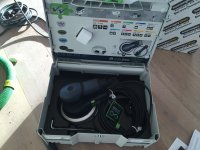Hi all,
I have just started building up a Festool family in my garage and now I want to add a sander. I have a small Metabo sander which is terrible for most work, so basically this new sander will be my only one. So I was thinking to buy RO150 or ETS EC 150/5, any one have a opinion on which to choose as my one (for now) sander? I know they are two quite different sanders, but the size of the ETS150 is interesting. I build mostly furniture so the use will be 90% sanding of planned oak and other hard woods.
Thanks for all answers.
I have just started building up a Festool family in my garage and now I want to add a sander. I have a small Metabo sander which is terrible for most work, so basically this new sander will be my only one. So I was thinking to buy RO150 or ETS EC 150/5, any one have a opinion on which to choose as my one (for now) sander? I know they are two quite different sanders, but the size of the ETS150 is interesting. I build mostly furniture so the use will be 90% sanding of planned oak and other hard woods.
Thanks for all answers.

